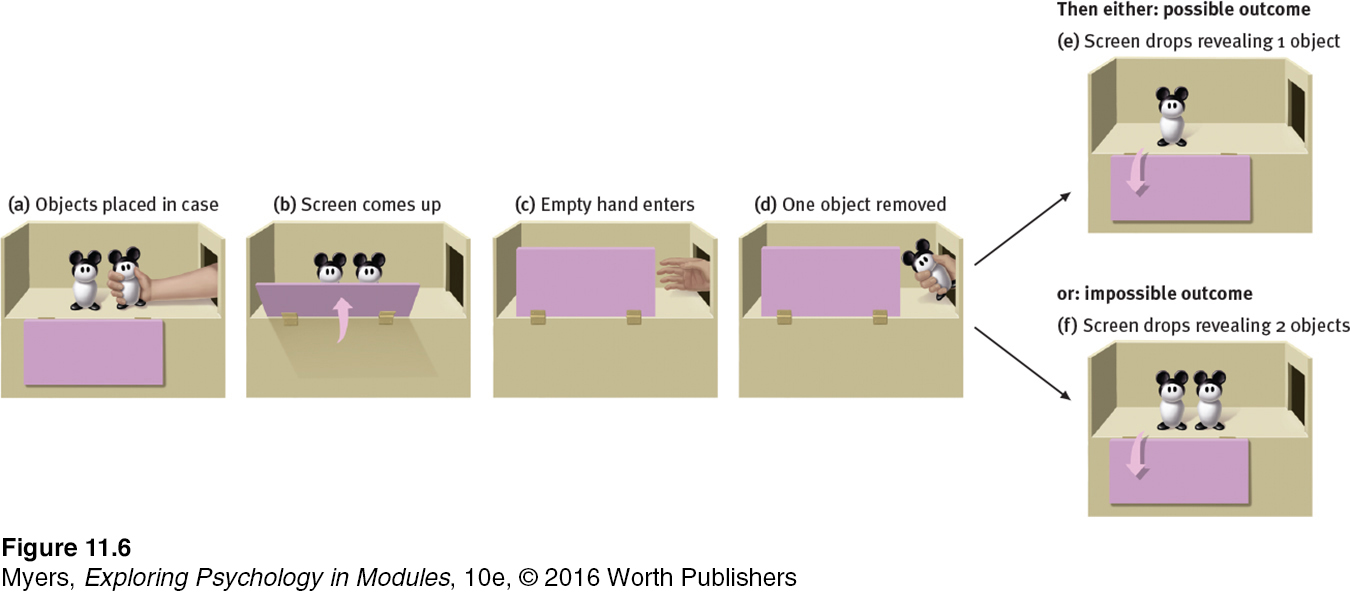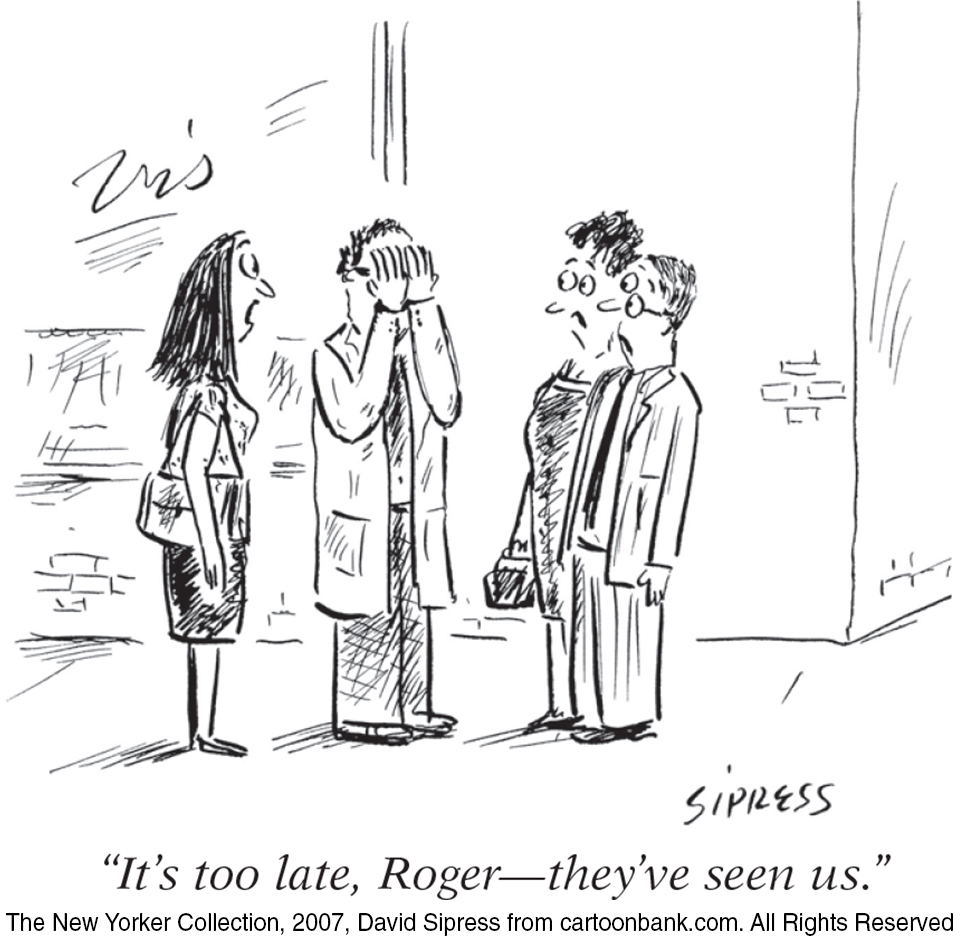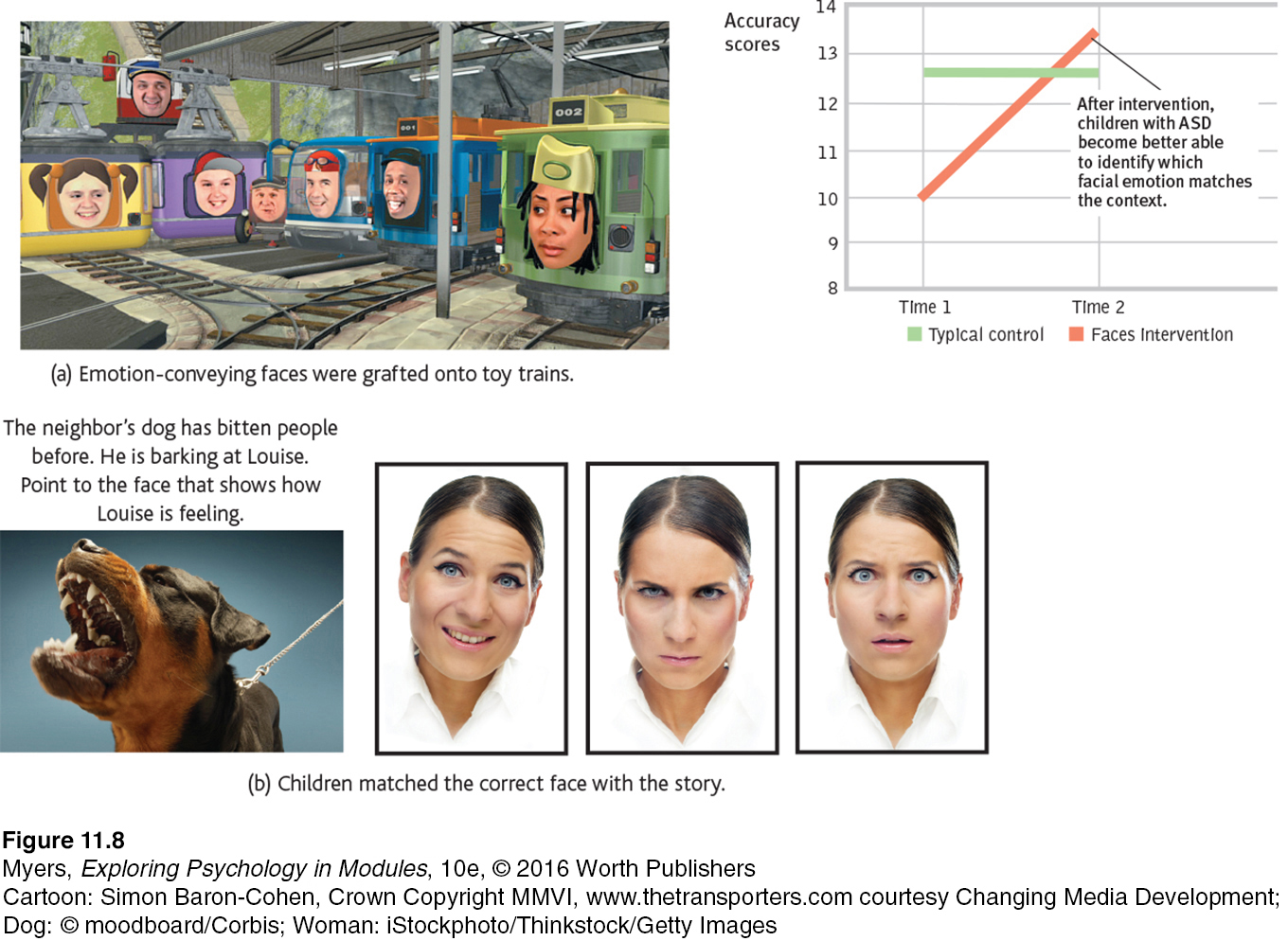11.2 Cognitive Development
11-
cognition all the mental activities associated with thinking, knowing, remembering, and communicating.
Somewhere on your life journey, you became conscious. When was that? Jean Piaget [pee-

A half-
Piaget’s studies led him to believe that a child’s mind develops through a series of stages, in an upward march from the newborn’s simple reflexes to the adult’s abstract reasoning power. Thus, an 8-
schema a concept or framework that organizes and interprets information.
Piaget’s core idea was that our intellectual progression reflects an unceasing struggle to make sense of our experiences. To this end, the maturing brain builds schemas, concepts or mental molds into which we pour our experiences. By adulthood we have built countless schemas, ranging from cats and dogs to our concept of love.
assimilation interpreting our new experiences in terms of our existing schemas.
accommodation adapting our current understandings (schemas) to incorporate new information.
To explain how we use and adjust our schemas, Piaget proposed two more concepts. First, we assimilate new experiences—
Piaget’s Theory and Current Thinking
Piaget believed that children construct their understanding of the world while interacting with it. Their minds experience spurts of change, followed by greater stability as they move from one cognitive plateau to the next, each with distinctive characteristics that permit specific kinds of thinking. In Piaget’s view, cognitive development consisted of four major stages—
sensorimotor stage in Piaget’s theory, the stage (from birth to nearly 2 years of age) during which infants know the world mostly in terms of their sensory impressions and motor activities.
SENSORIMOTOR STAGE In the sensorimotor stage, from birth to nearly age 2, babies take in the world through their senses and actions—
object permanence the awareness that things continue to exist even when not perceived.
Very young babies seem to live in the present: Out of sight is out of mind. In one test, Piaget showed an infant an appealing toy and then flopped his beret over it. Before the age of 6 months, the infant acted as if the toy ceased to exist. Young infants lack object permanence—the awareness that objects continue to exist when not perceived. By 8 months, infants begin exhibiting memory for things no longer seen. If you hide a toy, the infant will momentarily look for it (FIGURE 11.5). Within another month or two, the infant will look for it even after being restrained for several seconds.

So does object permanence in fact blossom suddenly at 8 months, much as tulips blossom in spring? Today’s researchers believe object permanence unfolds gradually, and they see development as more continuous than Piaget did. Even young infants will at least momentarily look for a toy where they saw it hidden a second before (Wang et al., 2004).
Researchers also believe Piaget and his followers underestimated young children’s competence. Preschoolers think like little scientists. They test ideas, make causal inferences, and learn from statistical patterns (Gopnik et al., 2015). Consider these simple experiments:
Baby physics: Like adults staring in disbelief at a magic trick (the “Whoa!” look), infants look longer at and explore an unexpected, impossible, or unfamiliar scene—
a car seeming to pass through a solid object, a ball stopping in midair, or an object violating object permanence by magically disappearing (Baillargeon, 1995, 2008; Shuwairi & Johnson, 2013; Stahl & Feigenson, 2015). Baby math: Karen Wynn (1992, 2000, 2008) showed 5-
month- olds one or two objects (FIGURE 11.6a). Then she hid the objects behind a screen, and visibly removed or added one (FIGURE 11.6d). When she lifted the screen, the infants sometimes did a double take, staring longer when shown a wrong number of objects (FIGURE 11.6f). But were they just responding to a greater or smaller mass of objects, rather than a change in number (Feigenson et al., 2002)? Later experiments showed that babies’ number sense extends to larger numbers, to ratios, and to such things as drumbeats and motions (Libertus & Brannon, 2009; McCrink & Wynn, 2004; Spelke et al., 2013). If accustomed to a Daffy Duck puppet jumping three times on stage, they showed surprise if it jumped only twice.

Clearly, infants are smarter than Piaget appreciated. Even as babies, we had a lot on our minds.
preoperational stage in Piaget’s theory, the stage (from about 2 to about 6 or 7 years of age) during which a child learns to use language but does not yet comprehend the mental operations of concrete logic.
conservation the principle (which Piaget believed to be a part of concrete operational reasoning) that properties such as mass, volume, and number remain the same despite changes in the forms of objects.
PREOPERATIONAL STAGE Piaget believed that until about age 6 or 7, children are in a preoperational stage—able to represent things with words and images but too young to perform mental operations (such as imagining an action and mentally reversing it). For a 5-

 For quick video examples of children being tested for conservation, visit LaunchPad’s Concept Practice: Piaget and Conservation.
For quick video examples of children being tested for conservation, visit LaunchPad’s Concept Practice: Piaget and Conservation.
PRETEND PLAY A child who can perform mental operations can think in symbols and enjoy pretend play. Researchers have found that symbolic thinking appears at an earlier age than Piaget supposed. Judy DeLoache (1987) showed children a model of a room and hid a miniature stuffed dog behind its miniature couch. The 2½-year-
egocentrism in Piaget’s theory, the preoperational child’s difficulty taking another’s point of view.
EGOCENTRISM Piaget contended that preschool children are egocentric: They have difficulty perceiving things from another’s point of view. They are like the person who, when asked by someone across a river, “How do I get to the other side?” answered “You are on the other side.” Asked to “show Mommy your picture,” 2-
“Do you have a brother?”
“Yes.”
“What’s his name?”
“Jim.”
“Does Jim have a brother?”
“No.”

Like Gabriella, TV-
“The curse of knowledge is the single best explanation I know of why good people write bad prose. It simply doesn’t occur to the writer that her readers don’t know what she knows.”
Psychologist Steven Pinker,
The Sense of Style, 2014
theory of mind people’s ideas about their own and others’ mental states—
THEORY OF MIND When Little Red Riding Hood realized her “grandmother” was really a wolf, she swiftly revised her ideas about the creature’s intentions and raced away. Preschoolers, although still egocentric, develop this ability to infer others’ mental states when they begin forming a theory of mind (Premack & Woodruff, 1978). The theory of mind concept was first used to describe chimpanzees’ seeming ability to read others’ intentions. Later, psychologists aimed to identify when humans develop a theory of mind.
As the ability to take another’s perspective gradually develops, preschoolers come to understand what made a playmate angry, when a sibling will share, and what might make a parent buy a toy. And they begin to tease, empathize, and persuade. Being able to take another’s perspective enables relationships. Children who have an advanced ability to understand others’ minds tend to be more popular (Slaughter et al., 2015).
Between about ages 3 and 4½, children worldwide come to realize that others may hold false beliefs (Callaghan et al., 2005; Rubio-
concrete operational stage in Piaget’s theory, the stage of cognitive development (from about 7 to 11 years of age) during which children gain the mental operations that enable them to think logically about concrete events.
CONCRETE OPERATIONAL STAGE By about age 7, said Piaget, children enter the concrete operational stage. Given concrete (physical) materials, they begin to grasp conservation. Understanding that change in form does not mean change in quantity, they can mentally pour milk back and forth between glasses of different shapes. They also enjoy jokes that use this new understanding:
Mr. Jones went into a restaurant and ordered a whole pizza for his dinner. When the waiter asked if he wanted it cut into 6 or 8 pieces, Mr. Jones said, “Oh, you’d better make it 6, I could never eat 8 pieces!” (McGhee, 1976)
Piaget believed that during the concrete operational stage, children become able to comprehend mathematical transformations and conservation. When my [DM’s] daughter, Laura, was 6, I was astonished at her inability to reverse simple arithmetic. Asked, “What is 8 plus 4?” she required 5 seconds to compute “12,” and another 5 seconds to then compute 12 minus 4. By age 8, she could answer a reversed question instantly.
formal operational stage in Piaget’s theory, the stage of cognitive development (normally beginning about age 12) during which people begin to think logically about abstract concepts.
FORMAL OPERATIONAL STAGE By about age 12, our reasoning expands from the purely concrete (involving actual experience) to encompass abstract thinking (involving imagined realities and symbols). As children approach adolescence, said Piaget, they can ponder hypothetical propositions and deduce consequences: If this, then that. Systematic reasoning, what Piaget called formal operational thinking, is now within their grasp.
Although full-
If John is in school, then Mary is in school. John is in school. What can you say about Mary?
Formal operational thinkers have no trouble answering correctly. But neither do most 7-
Piaget’s Stages of Cognitive Development
| Typical Age Range | Description of Stage | Developmental Phenomena |
|---|---|---|
| Birth to nearly 2 years |
Sensorimotor Experiencing the world through senses and actions (looking, hearing, touching, mouthing, and grasping) |
|
| About 2 to about 6 or 7 years |
Preoperational Representing things with words and images; using intuitive rather than logical reasoning |
|
| About 7 to 11 years |
Concrete operational Thinking logically about concrete events; grasping concrete analogies and performing arithmetical operations |
|
| About 12 through adulthood |
Formal operational Abstract reasoning |
|
An Alternative Viewpoint: Lev Vygotsky and the Social Child

As Piaget was forming his theory of cognitive development, Russian psychologist Lev Vygotsky was also studying how children think and learn. He noted that by age 7, they increasingly think in words and use words to solve problems. They do this, he said, by internalizing their culture’s language and relying on inner speech (Fernyhough, 2008). Parents who say “No, no!” when pulling a child’s hand away from a cake are giving the child a self-
Where Piaget emphasized how the child’s mind grows through interaction with the physical environment, Vygotsky emphasized how the child’s mind grows through interaction with the social environment. If Piaget’s child was a young scientist, Vygotsky’s was a young apprentice. By mentoring children and giving them new words, parents and others provide a temporary scaffold from which children can step to higher levels of thinking (Renninger & Granott, 2005). Language, an important ingredient of social mentoring, provides the building blocks for thinking, noted Vygotsky (who was born the same year as Piaget, but died prematurely of tuberculosis).

RETRIEVE IT
Question
Object permanence, pretend play, conservation, and abstract logic are developmental milestones for which of Piaget's stages, respectively?
Match the correct cognitive developmental stage to each developmental phenomenon.
Question
Thinking about abstract concepts, such as “freedom.” Enjoying imaginary play (such as dress- Understanding that physical properties stay the same even when objects change form. | Formal operational Concrete operational Preoperational |
Question
Having the ability to reverse math operations. Understanding that something is not gone for good when it disappears from sight, as when Mom “disappears” behind the shower curtain. Having difficulty taking another's point of view (as when blocking someone's view of the TV). | Concrete operational Preoperational Sensorimotor |
Reflecting on Piaget’s Theory
“Assessing the impact of Piaget on developmental psychology is like assessing the impact of Shakespeare on English literature.”
Developmental psychologist
Harry Beilin (1992)
What remains of Piaget’s ideas about the child’s mind? Plenty—
 For a 7-
For a 7-
However, today’s researchers see development as more continuous than did Piaget. By detecting the beginnings of each type of thinking at earlier ages, they have revealed conceptual abilities Piaget missed. Moreover, they see formal logic as a smaller part of cognition than he did. Piaget would not be surprised that today, as part of our own cognitive development, we are adapting his ideas to accommodate new findings.
“Childhood has its own way of seeing, thinking, and feeling, and there is nothing more foolish than the attempt to put ours in its place.”
Philosopher Jean-
IMPLICATIONS FOR PARENTS AND TEACHERS Future parents and teachers, remember this: Young children are incapable of adult logic. Preschoolers who block one’s view of the TV simply have not learned to take another’s viewpoint. What seems simple and obvious to us—
Autism Spectrum Disorder
11-
autism spectrum disorder (ASD) a disorder that appears in childhood and is marked by significant deficiencies in communication and social interaction, and by rigidly fixated interests and repetitive behaviors.
Diagnoses of autism spectrum disorder (ASD), a disorder marked by social deficiencies and repetitive behaviors, have been increasing. Once believed to affect 1 in 2500 children (and referred to simply as autism), ASD now gets diagnosed in 1 in 68 American children by age 8. But the reported rates vary by place, with New Jersey having four times the reported prevalence of Alabama, while Britain’s children have a 1 in 100 rate, and South Korea’s 1 in 38 (CDC, 2014; Kim et al., 2011; NAS, 2011). The increase in ASD diagnoses has been offset by a decrease in the number of children with a “cognitive disability” or “learning disability,” which suggests a relabeling of children’s disorders (Gernsbacher et al., 2005; Grinker, 2007; Shattuck, 2006).

The underlying source of ASD’s symptoms seems to be poor communication among brain regions that normally work together to let us take another’s viewpoint. From age 2 months on, as other children spend more and more time looking into others’ eyes, those who later develop ASD do so less and less (Jones & Klin, 2013). People with ASD are said to have an impaired theory of mind (Rajendran & Mitchell, 2007; Senju et al., 2009). Mind reading that most of us find intuitive (Is that face conveying a smirk or a sneer?) is difficult for those with ASD. They have difficulty inferring and remembering others’ thoughts and feelings, learning that twinkling eyes mean happiness or mischief, and appreciating that playmates and parents might view things differently (Boucher et al., 2012; Frith & Frith, 2001). Partly for such reasons, a national survey of parents and school staff reported that 46 percent of adolescents with ASD had suffered the taunts and torments of bullying—
ASD has differing levels of severity. Some (those diagnosed with what used to be called Asperger syndrome) generally function at a high level. They have normal intelligence, often accompanied by exceptional skill or talent in a specific area, but deficient social and communication skills and a tendency to become distracted by irrelevant stimuli (Remington et al., 2009). Those at the spectrum’s lower end struggle to use language at all.

Biological factors, including genetic influences and abnormal brain development, contribute to ASD (State & Šestan, 2012). Studies suggest that the prenatal environment matters, especially when altered by maternal infection and inflammation, psychiatric drug use, or stress hormones (NIH, 2013; Wang, 2014). Childhood MMR vaccinations do not contribute to ASD (Demicheli et al., 2012; DeStefano et al., 2013). Based on a fraudulent 1998 study—
Both boys and girls can have ASD, but there are large gender differences. ASD afflicts about four boys for every girl. Children for whom amniotic fluid analyses indicated high prenatal testosterone develop more masculine and ASD-
Numerous studies verify biology’s influence. If one identical twin is diagnosed with ASD, the chances are 50 to 70 percent that the co-

Researchers are also sleuthing ASD’s telltale signs in the brain’s structure. Several studies have revealed underconnectivity—
Biology’s role in ASD also appears in the brain’s functioning. People without ASD often yawn after seeing others yawn. And as they view and imitate another’s smiling or frowning, they feel something of what the other is feeling. Not so among those with ASD, who are less imitative and show much less activity in brain areas involved in mirroring others’ actions (Dapretto et al., 2006; Perra et al., 2008; Senju et al., 2007). When people with ASD watch another person’s hand movements, for example, their brain displays less-
Seeking to “systemize empathy,” Baron-

RETRIEVE IT
Question
What does theory of mind have to do with autism spectrum disorder?